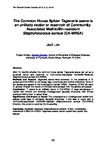The Common House Spider Tegenaria saeva is an unlikely vector or reservoir of Community-Associated Methicillin-resistant Staphylococcus aureus (CA-MRSA)
Date
2011Author
Subject
Metadata
Show full item recordAbstract
Aim: To identify whether the common house spider Tegenaria saeva can act as a potential vector and reservoir of Community-Associated Methicillin-Resistant Staphylococcus aureus (CA-MRSA). Methods and Results: Tegenaria saeva were screened for the presence of S. aureus and CA-MRSA on the fangs, legs, outer body and internal microflora. None of the spiders processed in this investigation carried MRSA. However, 37.5% did carry S. aureus. Overall, low levels of microbes were isolated from the spiders processed. Conclusion: T. saeva is an unlikely vector of CA-MRSA. A large percentage of "spider bite‟ lesions are normally misdiagnosed bacterial infections, with limited evidence linking them to spider bites. Significance and Impact of Study: The consequence of misdiagnosed "spider bite‟ lesions could lead to untreated bacterial infections. If this was to occur with a community-associated Methicillin-resistant Staphylococcus aureus (CA-MRSA) infection, the outcome could be life threatening.
Citation
Lee, J. (2011) 'The Common House Spider Tegenaria saeva is an unlikely vector or reservoir of Community-Associated Methicillin-resistant Staphylococcus aureus (CA-MRSA)', The Plymouth Student Scientist, 4(1), p. 40-50.
Publisher
Journal
Volume
Issue
Recommended, similar items
The following license files are associated with this item:



